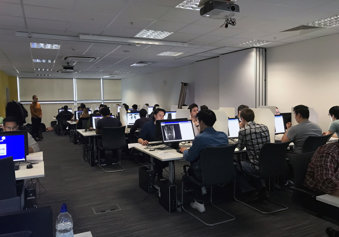FRCR Part 2B (Radiology) - purpose of assessment statement
Overview
The various components of the Fellowship of the Royal College of Radiologists (FRCR) examinations have been designed to assess the knowledge and skills of clinical radiology trainees as they progress through a number of levels of competence and to demonstrate readiness to progress to the next stage of training.
The award of the FRCR indicates that the candidate has attained the required level of competence across the components of the core curriculum. The Final FRCR Part B is not designed as an exit examination, but instead marks an important step in the progression of trainees towards the ability to use their knowledge and skills as independent practitioners. At the same time the examination provides the public with an assurance that radiologists in training are being assessed to a consistently high standard and that the holders of the Fellowship have achieved a nationally recognised high quality of clinical performance.
The Final FRCR Examination has three components: short case reporting; long case reporting; and an oral examination. The three parts of the examination assess different aspects of a candidate’s radiological skills, all of which are considered necessary for safe and effective radiological practice. All components are presented digitally using computer workstations.
Short cases
Plain radiographic interpretation is an essential skill for radiologists, particularly in the areas of paediatric imaging and chest imaging. The short case component is intended to assess a candidate’s ability to assess and interpret plain radiographs, including some complex plain radiographs, across a variety of clinical cases and pathologies. It also assesses the ability to accurately communicate findings, and recommendations for further management, allowing for in-depth assessment of this key skill which forms a large part of the radiological workload.
The coverage of chest, musculoskeletal and abdominal X-rays is approximately:
- CXR: 50-60% of the exam set
- MSK: 40-50% of the exam set
- AXR: up to 4% (1 question) of the exam set
The coverage of adult and paediatric cases is approximately:
- Adult cases: approximately 75%
- Paediatric cases: approximately 25%
Long cases
The long case component recognises that radiologists largely communicate their findings in the form of written reports. This element tests the ability of the candidate to make a number of observations, distinguish the relevance of these findings, deduce a list of differential diagnoses, suggest the most likely diagnosis and discuss further management including further imaging where appropriate. This part of the examination mirrors a mixed list of cross-sectional and fluoroscopic imaging. Each case can include any type of radiological imaging and often involves more than one e.g. plain film, CT and isotope study.
This written element of the examination aims to test the candidate’s ability to assess and interpret a variety of clinical cases across all modalities safely, and to accurately communicate their findings, conclusions and recommendations.
Oral examination
The oral component further assesses the candidate’s powers of observation and interpretation, but in addition allows assessment of the candidate’s ability to discuss wide-ranging aspects of patient care as influenced by the radiological findings. This mirrors the day-to-day clinical discussions and MDT meetings, which form an integral part of a radiologist’s workload.
Candidates are expected to be able to integrate their observations with emerging clinical information to help refine their differential diagnosis. The oral component also tests their ability to communicate effectively, their analytical and decision-making skills, and allows searching questions to explore their depth of knowledge and ensure that their practice supports patient safety.
The oral format allows the examiners the unique opportunity to explore the candidates’ depth of knowledge and to test higher cognitive skills, allowing for flexibility and complexity to be built into the examiners’ interactions with candidates.
Our CR2B exams
Return to the main page to find out more about our FRCR Part 2B exam
